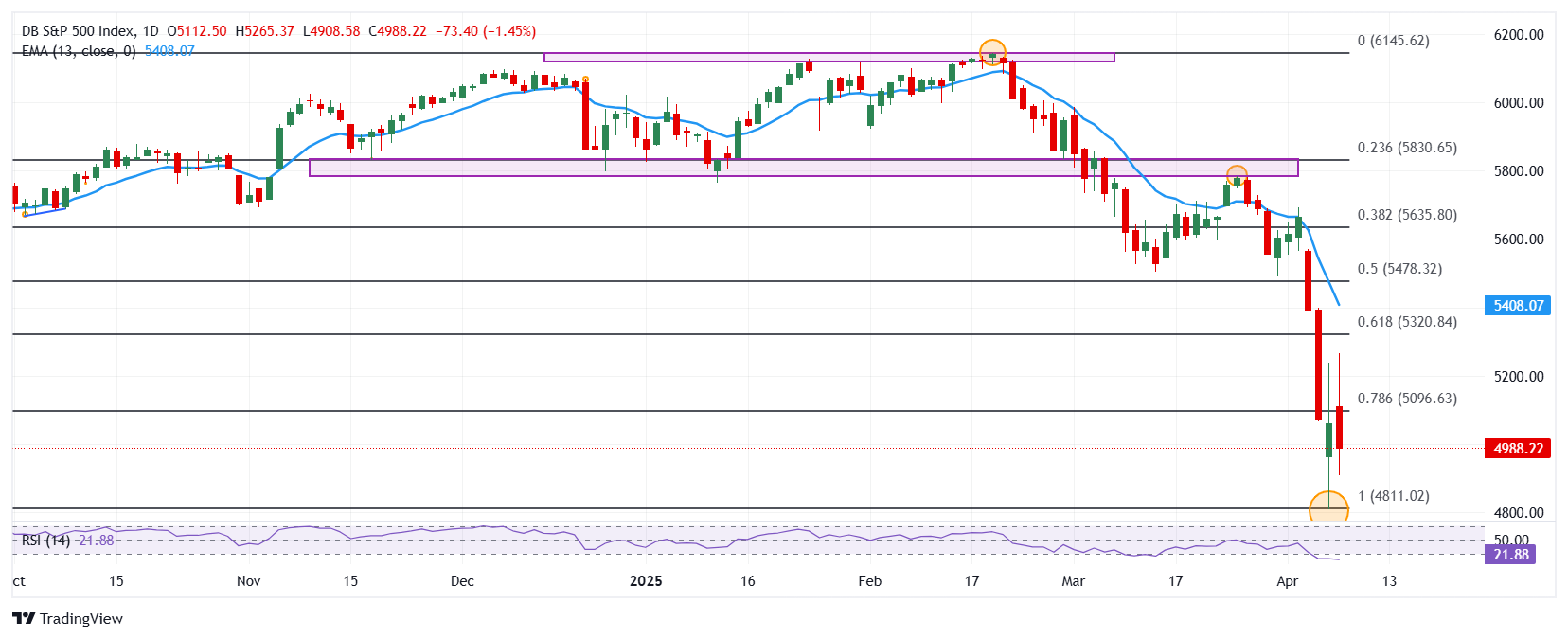- The S&P 500 share index loses 1.45% daily, operating when writing about 4,988.
- The White House confirmed the imposition of total tariffs of 104% to China, effective as of April 9.
- The president of the San Francisco Federal Reserve, Mary Daly, showed her concern about the inflationary pressure caused by tariffs.
- The attention of the operators will focus on the publication of the Minutes of the Federal Reserve.
The S&P 500 reacted down from April 4 to 5,265, attracting aggressive vendors that dragged the index to a minimum of the day in 4,908. Currently, the S&P 500 operates over 4,988, falling 1.45% today.
Tariff climbing increases fears in financial markets
The press secretary, Karoline Leavitt, today announced the imposition of total 104% tariffs on China effective as of April 9, in retaliation to the 34% tariffs that China applied to US exports.
In this context, the S&P 500 resumed the bearish perspective, falling 1.45% today, losing 73 points, consolidating within the operating range of Monday’s session in 4,988.
On the other hand, Mary Daly, president of the San Francisco Federal Reserve, showed her concern about the inflationary risks caused by tariffs.
The look of the investors will be put tomorrow in the publication of the Minutes of the Federal Reserve, where more clarity will be sought in the rate of type cuts in the face of tariff uncertainty.
Levels to be considered in the S&P 500
The S&P 500 reacted down from a short -term resistance given by the maximum of March 25 in 5,784. The next key resistance is observed in 6,145, maximum of February 19. To the south, the important support is in 4,662, pivot point of January 5, 2024.
S&P 500 DAILY GRAPH

S&P 500 FAQS
The S&P 500 is a very often stock index that measures the yield of 500 public companies and is considered a wide measure of the US stock market. The influence of each company on the calculation of the index is weighted based on stock capitalization. This is calculated by multiplying the number of bought shares of the company for the price of the action. The S&P 500 index has achieved impressive yields: 1.00 $ invested in 1970 would have produced a yield of almost $ 192.00 in 2022. The average annual profitability since its creation in 1957 has been 11.9%.
Companies are selected by committee, unlike other indices included in established standards. Even so, they must fulfill certain eligibility criteria, the most important of which is stock market, which must be equal to or greater than 12.7 billion dollars. Other criteria are liquidity, domicile, stock capitalization, sector, financial viability, quotation time and representation of the sectors of the United States economy. The nine largest companies in the index represent 27.8% of the stock market capitalization.
There are several ways to operate with the S&P 500. Most of the Stred Betting retail runners and platforms allow operators to use contracts per difference (CFD) to make bets on the price direction. In addition, indexed funds, investment funds and quoted funds (ETF) that follow the price of the S&P 500 can be purchased. The most ETF liquid is the ETF of the London Stock Exchange. The most ETF liquid is the State Street Corporation Spy. The Chicago Mercantile Exchange (CME) offers futures contracts on the index and the Chicago Board of Options (CMOE) offers options, as well as ETF, ETF Inverse and ETF leverage.
There are many factors that promote S&P 500, but mainly it is the aggregate performance of the companies that compose it, revealed in their reports of quarterly and annual results. American and world macroeconomic data also contribute, since they influence investors’ confidence, which is positive drives profits. The level of interest rates, set by the Federal Reserve (FED), also influences the S&P 500, since it affects the cost of credit, which is largely depending on many companies. Therefore, inflation can be a determining factor, as well as other parameters that influence the decisions of the Federal Reserve.
Source: Fx Street
I am Joshua Winder, a senior-level journalist and editor at World Stock Market. I specialize in covering news related to the stock market and economic trends. With more than 8 years of experience in this field, I have become an expert in financial reporting.







